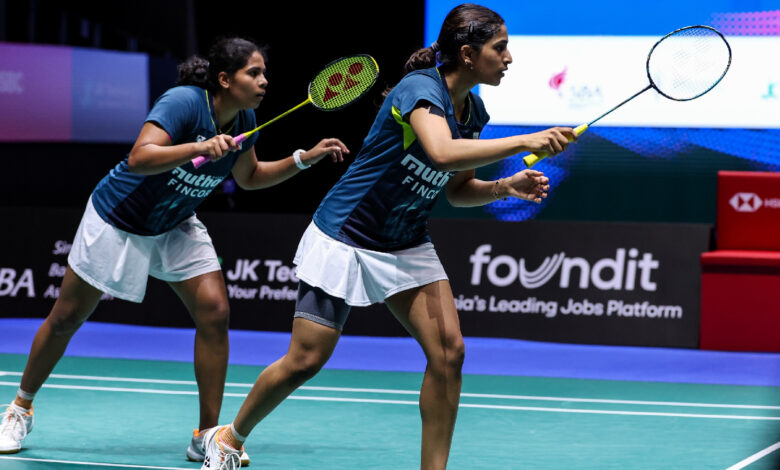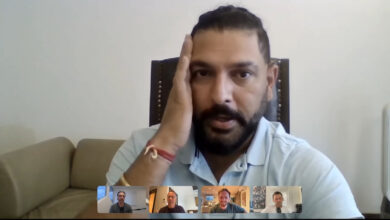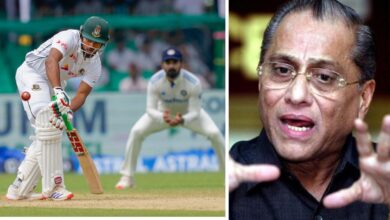Treesa Jolly and Gayatri Gopichand face a swarm of women doubles pairings from China, Taiwan and Japan | Badminton News

At the Macau Open Badminton, Chinese Taipei casually unleashed 35 doubles pairings — across women’s, men’s and mixed doubles categories — at the neighbouring Super 300 event, this week. Five Taiwanese women’s doubles pairings out of the 12 in the main draw, lined up in the quarterfinals.It meant that India’s Treesa Jolly-Gayatri Gopichand, have already parried off two CT combinations in the last two days. And will take on a third, Pei Shan Hsieh and En-Tzu Hung in the semis, with possibly a fourth one in the finals, coming out the lower half of the draw. The other probability, should the third seeded Indians make the finals, is a young rampaging Chinese pairing, not immediately well-known, but poised to burst through the wings with their typically scorching game.
These are the phalanxes from East Asian powerhouses China, Taiwan and Japan, silently chipping away at their games behind training curtains in the previous Olympic cycles, who land at tournaments in hoardes, and make immediate impacts, going on to rise through the ranks at dizzy speeds. Rankings are pretty much a joke when gauging the might of these next-wave of challengers because they rarely show up on the international circuit, till a new Olympic cycle begins.
The 35 entries may be late-teens and early 20s, or domestic second or third strings from these badminton factories, who seldom receive funding if they aren’t necessarily Top 10 material to play internationally, though Macau is just a 700 km hop away for the Taipese. But the level of their pickled games, technical finesse, can be quite intimidating especially if they show up unseeded.
Treesa-Gayatri are 21 years old, but have been on the circuit and hence under magnified scrutiny for three seasons now. While they remain the highest-ranked pairings left in the Macau draw, the path to their first Super 300 title, over the next two days, isn’t going to be a walk in the park.
On Friday at the Macao East Asian Games dome, with its flying fast shuttle, the third seeded Indians were dominant against Yin-Hui Hsu and Jhih Yun Lin, winning the quarters 21-12, 21-17 in 39 minutes.
In the opening set, the Indians pushed the accelerator in the 11th to 15th point phase, in scalding flow against the sixth seeds.
Treesa-Gayatri are 21 years old, but have been on the circuit and hence under magnified scrutiny for three seasons now. ( AP | PTI)
And in the second, though the Taipese briefly led 13-10, the Indians effected a smooth turning of tables, picking 8 of the next 9 points, to saunter to a win against the 34th ranked pair, aged 21 and 25.
Treesa relished the fast conditions to rain down smashes, and Gayatri was sturdy operating from a few steps behind the net as the opponents barely blocked and resorted to drives and lifts.
In the semis, they run into slightly more experienced eighth seeds, again from Taipei, and will be expected to lock in their first title of S300 category. Interestingly, Macau was where PV Sindhu won three back-to-back titles alongside her early World Championships bronzes, before she hit the bigtime at Olympics, when the tournament used to be a beginners grade event.
But this year has seen particular flooding from the Taipese developmental pairings, bolstered their second straight Olympics gold in men’s doubles, through Lee Yang and Wang Chi-lin.
The higher grade tournaments are similarly teeming though there’s no visible name on the surface. There are no CT women’s doubles pairings in the world’s Top 25, but there’s suddenly 5 bunched to break out in Top 35. Macau, though, is the earliest example of the sheer numbers that China and Chinese Taipei plan to let loose on the world, in a pretty scary scenario, given their high base competence. They are currently hidden somewhere on Page 3 of the rankings charts, but their movement hikes are like 19 or 38 places at a time, as they go about picking smaller titles.
Several women doubles pairings in international Top 15 from China, Korea and Japan are getting phased out or being reshuffled. But just below the surface, there’s a throbbing bunch of young upstarts not just from the Chinese mainland but also a rejuvenated Taipei jostling to burst out the wings.
The Indians, ranked 23, are still battling some niggles, but are staring at a daunting scenario just in terms of playing styles – faster, more attacking and power-packed, given the current World No.3, Liu Sheng Shu (20 years old) and Tan Ning (21) of China have stirred up the template of the game to make it more frenzied than before. Not unlike their semiconductor-innovation races, what happens in China today, might well have happened in Taiwan yesterday, but will show up in the results in coming months — a trend badminton has followed.
India has 4 women doubles pairings, not quite in a limbo, but not surging either, in the Top 50 (and 8 dawdling in all in Top 100), though Olympian Tanisha Crasto is making a serious charge at the mixed doubles category, where her game is more suited. The 47th ranked Panda sers – Rituparna and Swetaparna, and No.50 Priya Konjengbam and Shruti Mishra are earnest triers, but haven’t made much headway, on the road, and will need a good Indian swing to move up.
As such, Treesa-Gayatri hoping for a title breakthrough, will have to manage their injury-forced breaks and hitting top gear, amidst these Macau-like swirls from the powerhouses. It starts with the semifinals against Hsieh-Hung on Saturday, the CT sample of what is to come.





